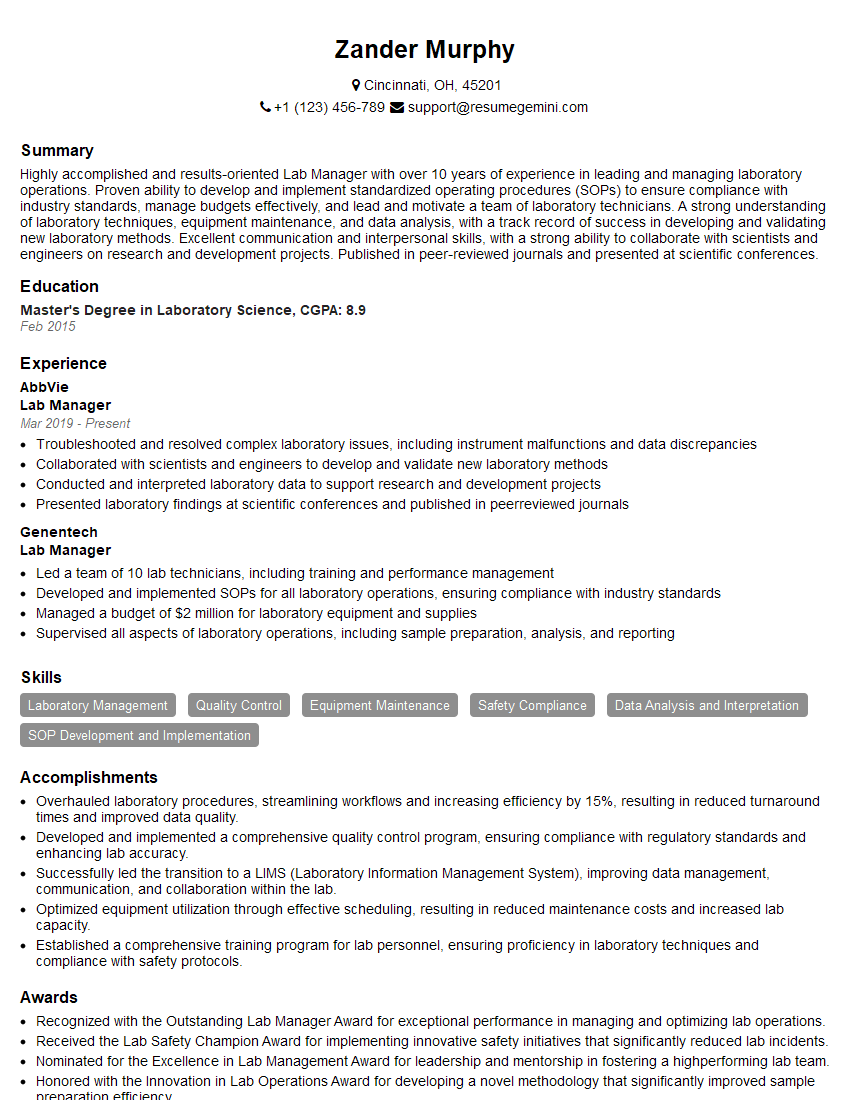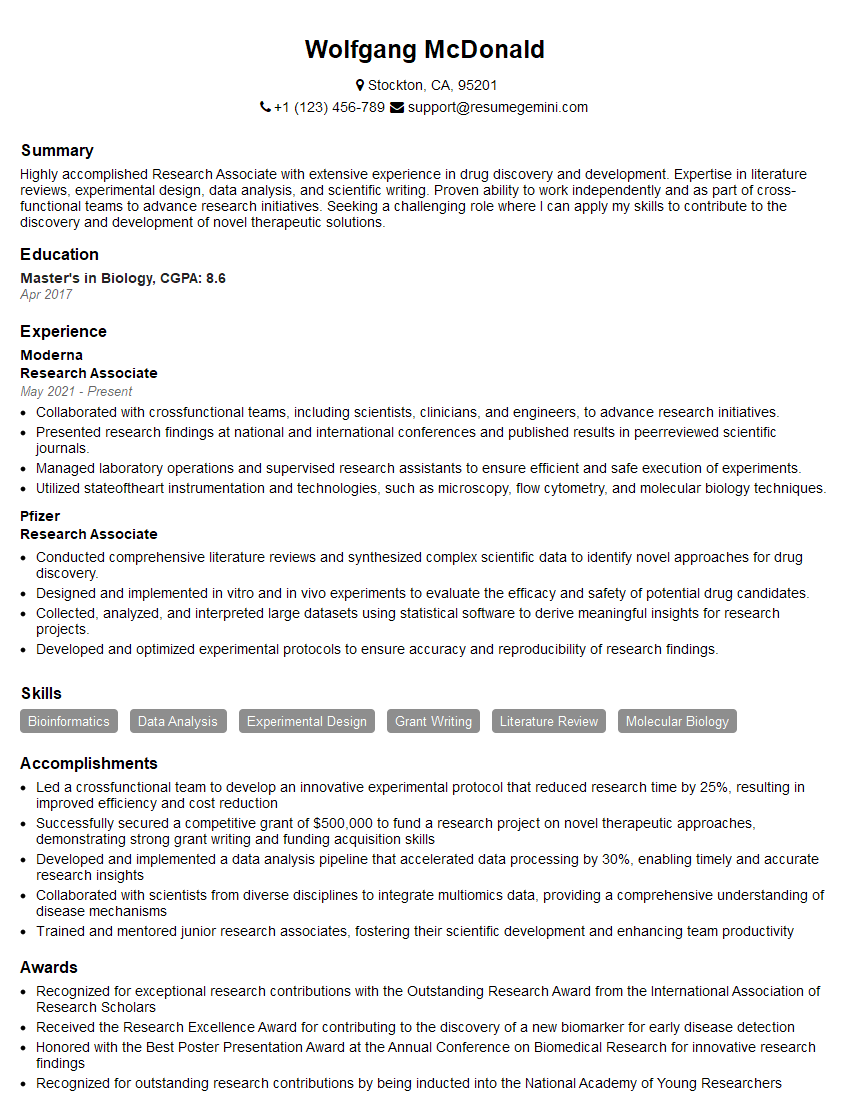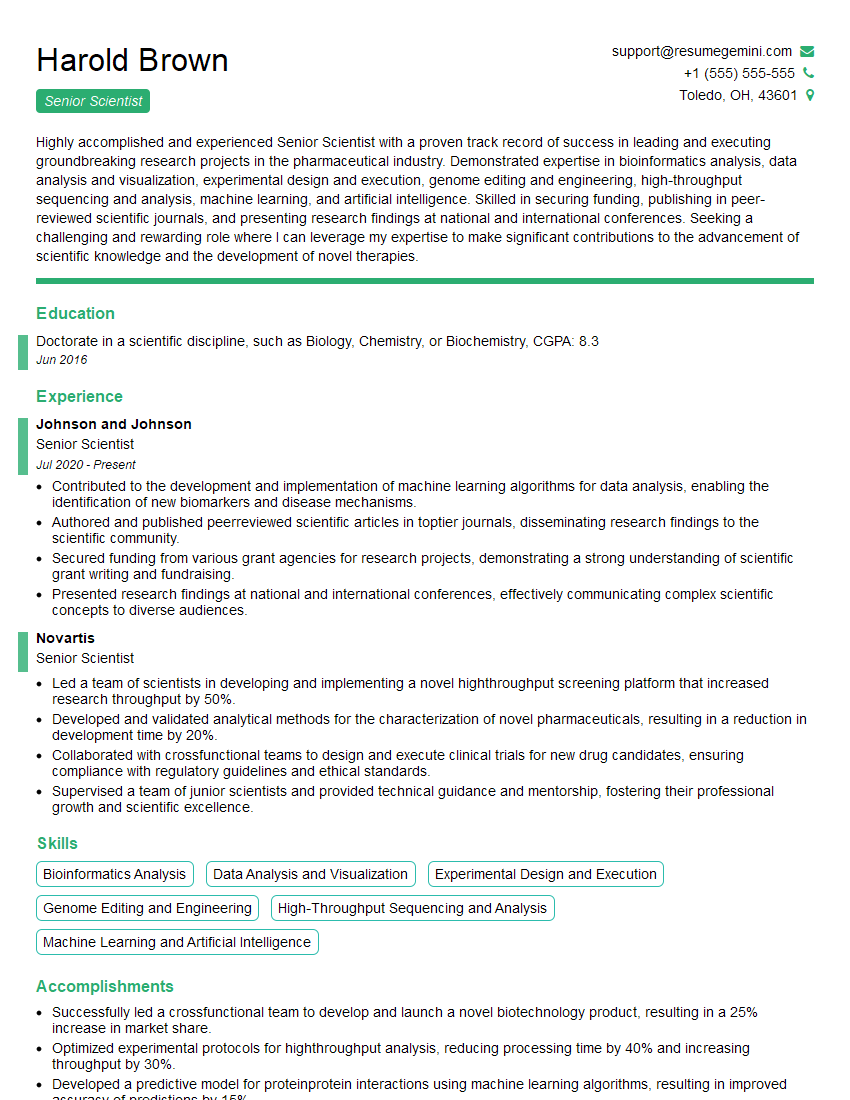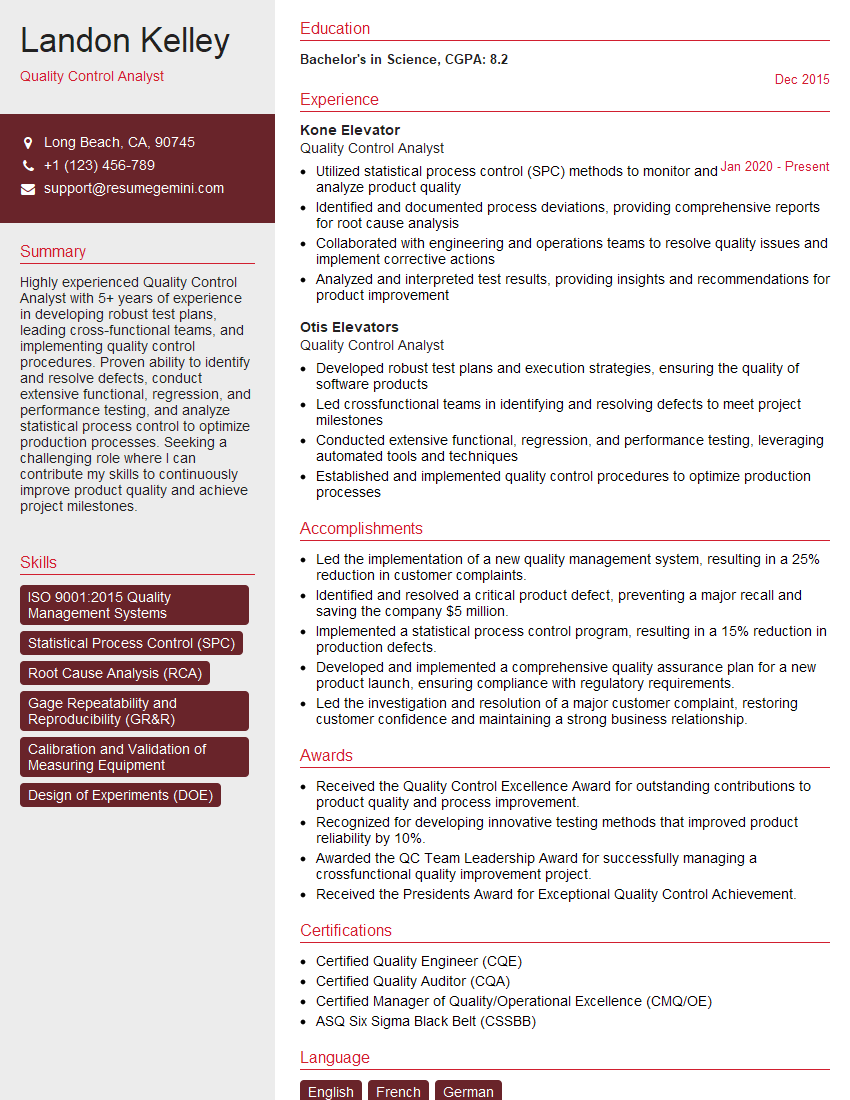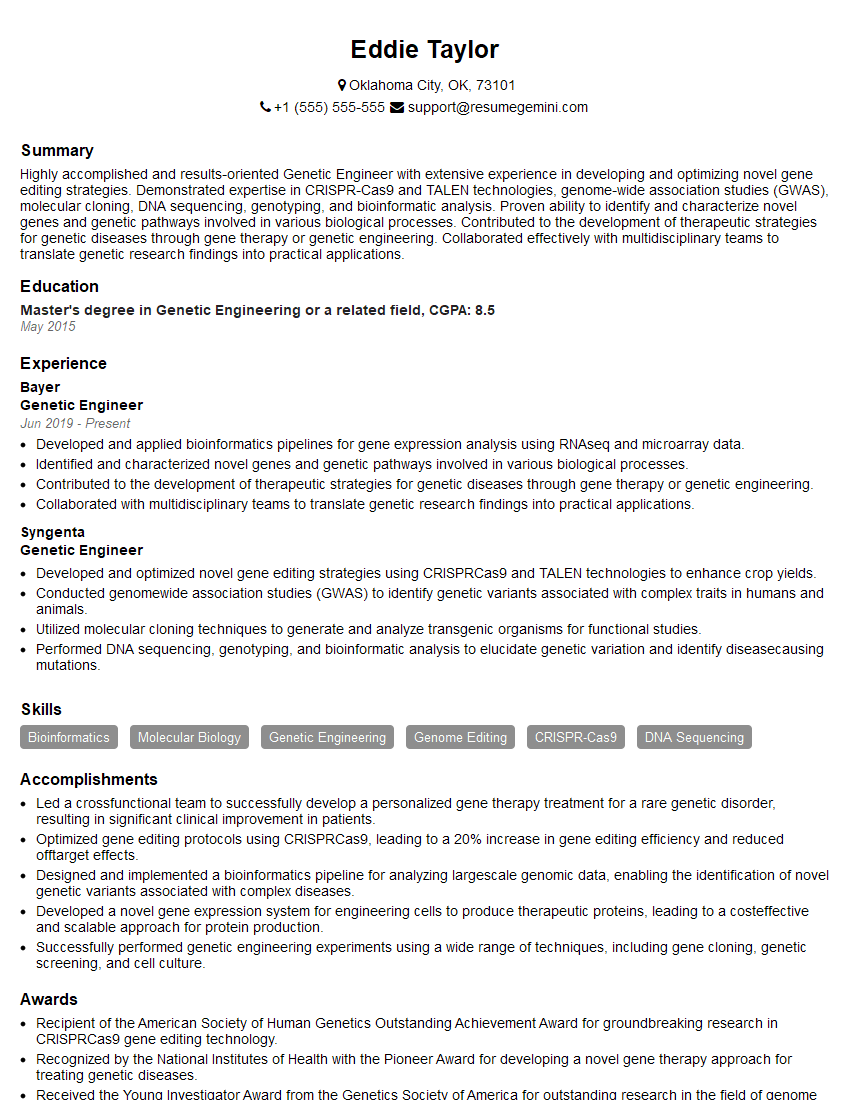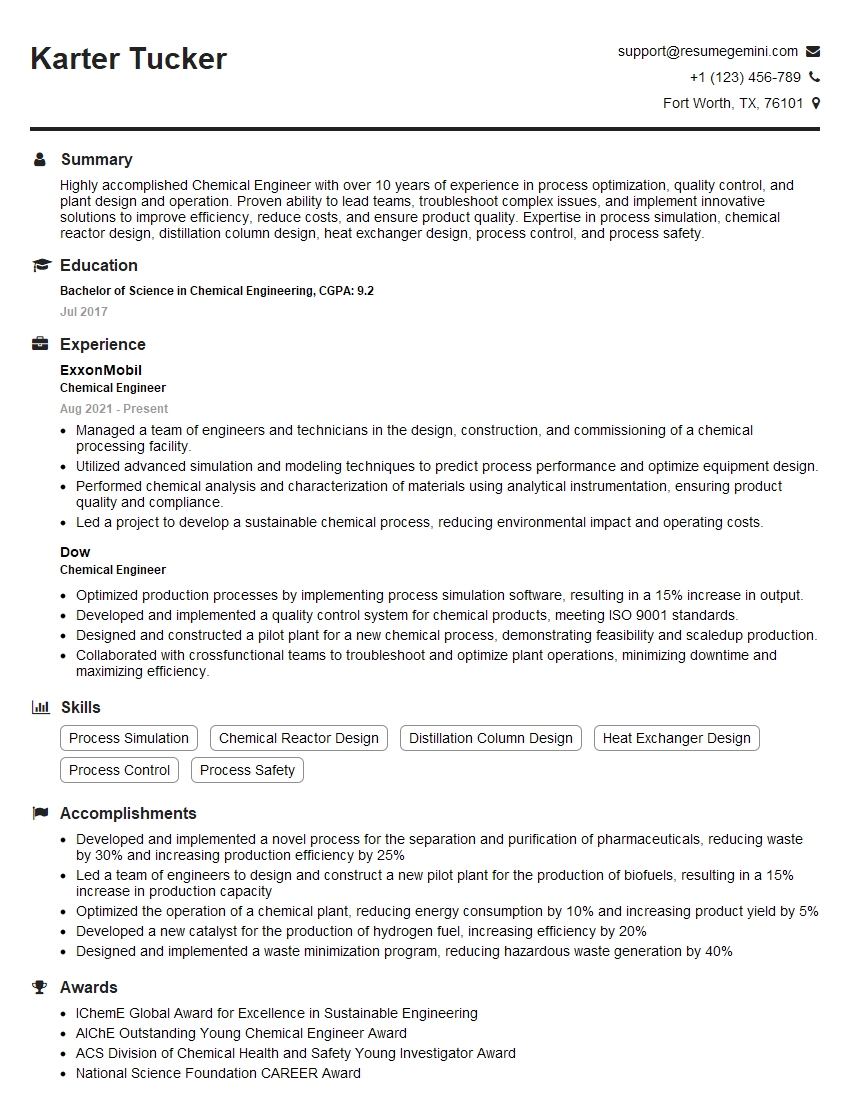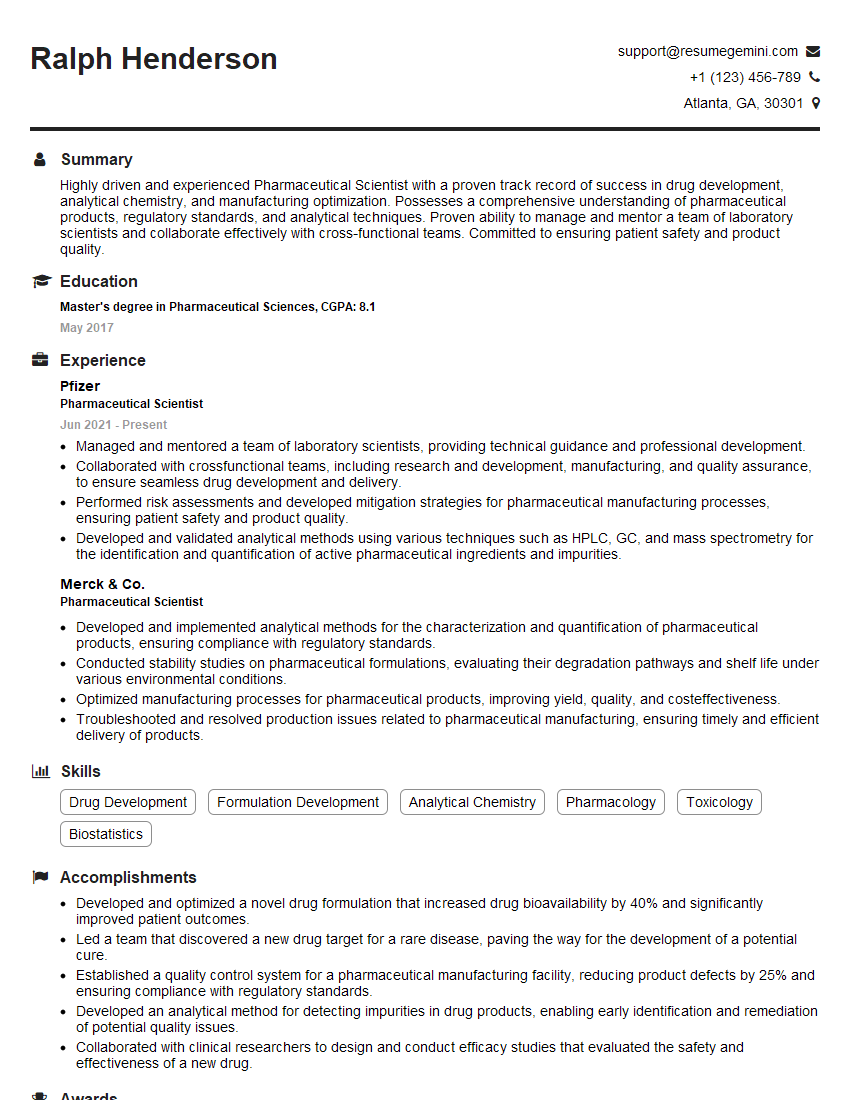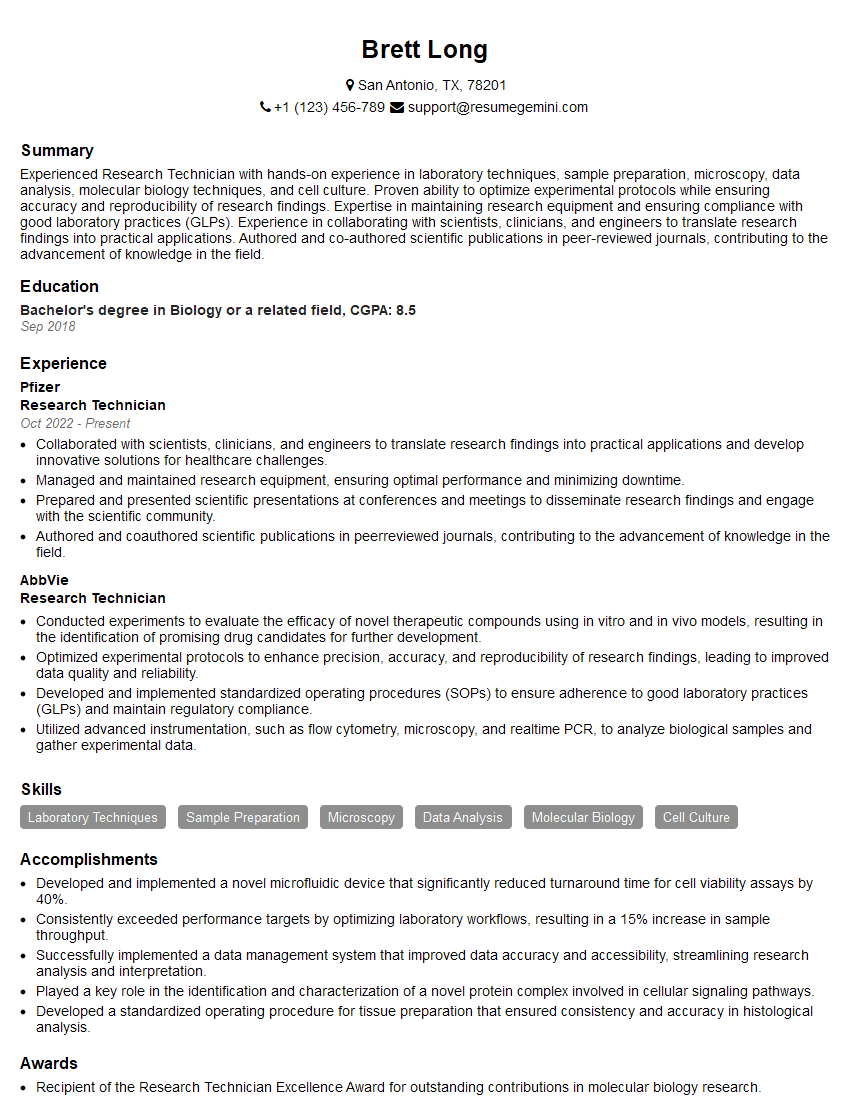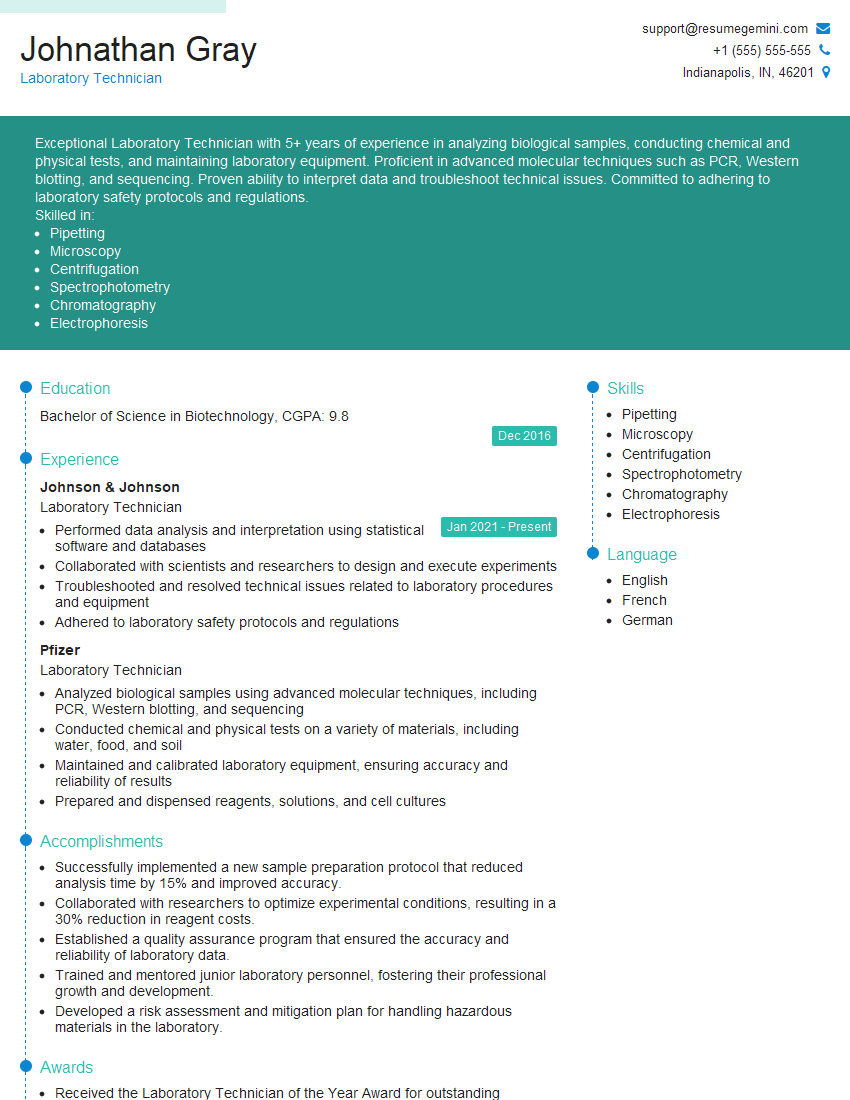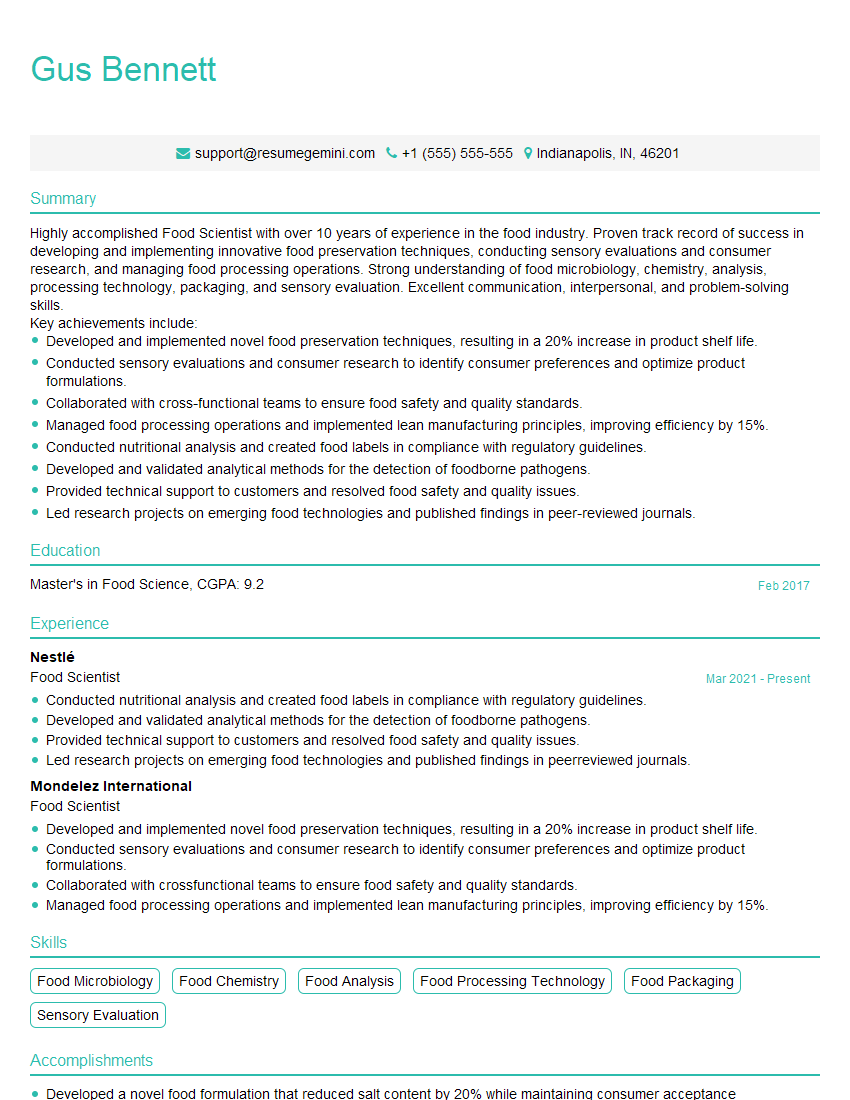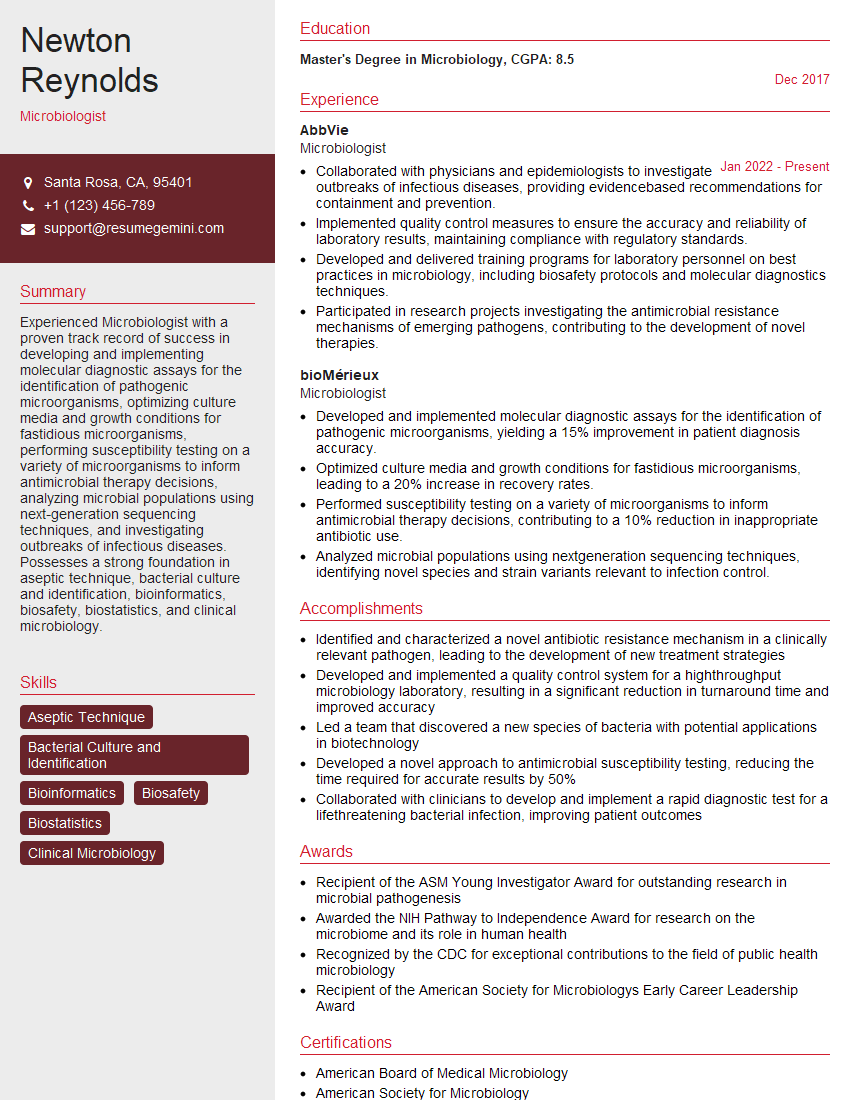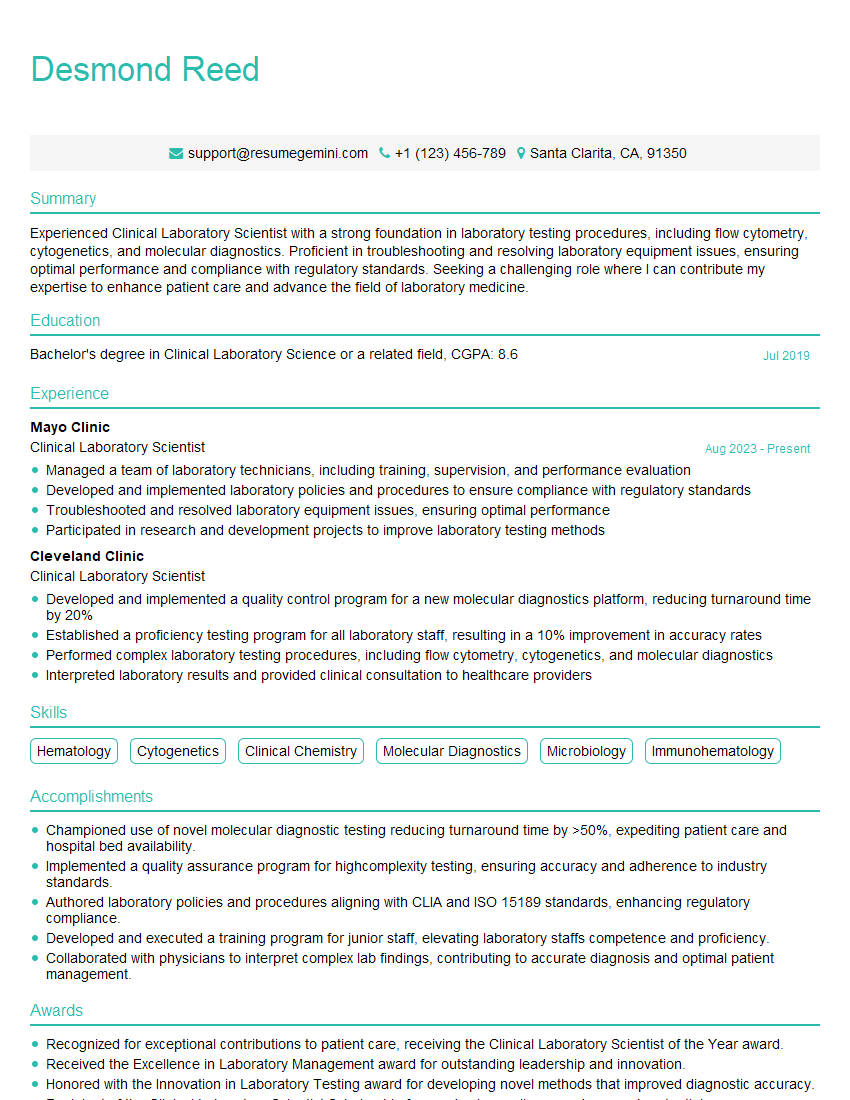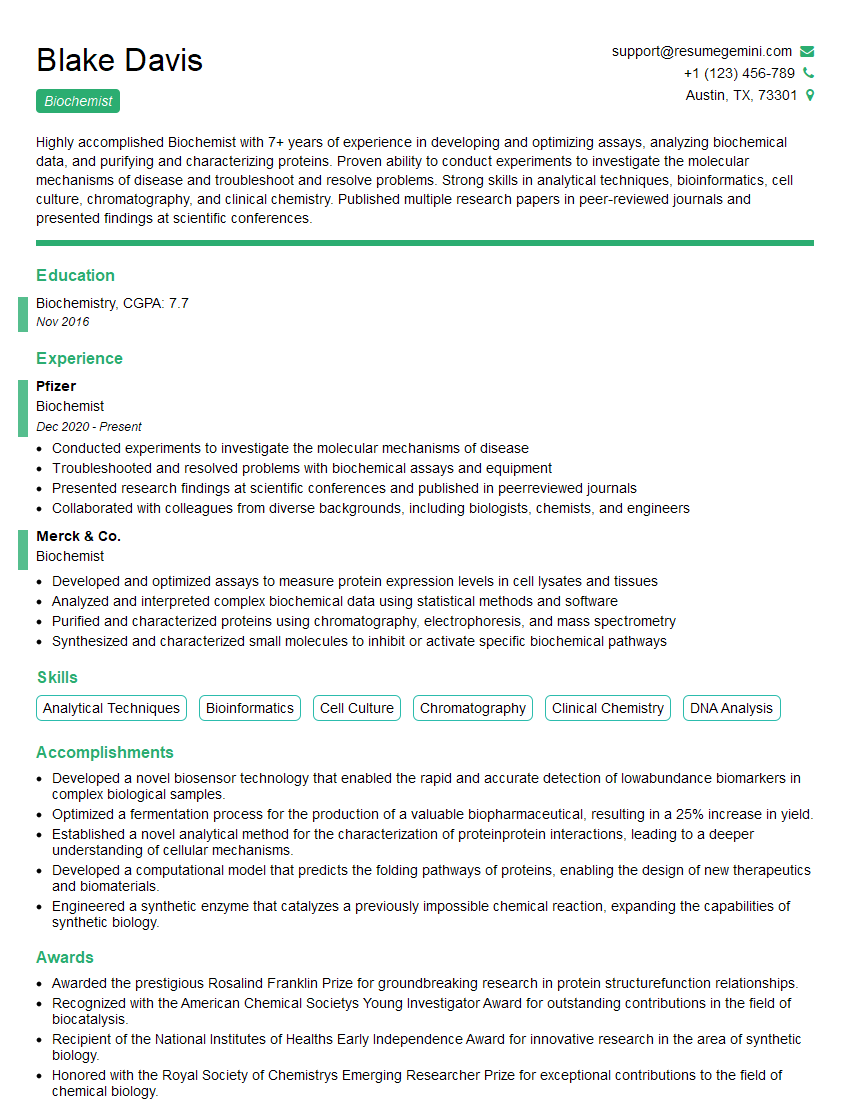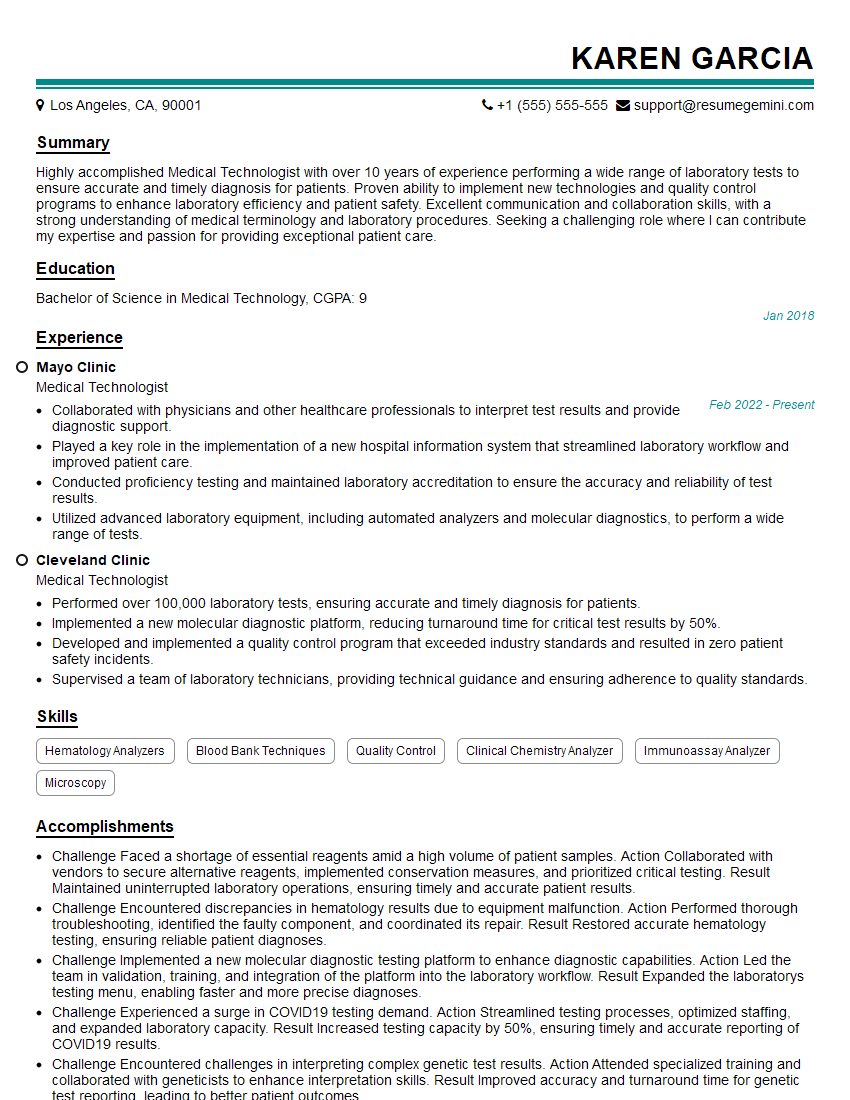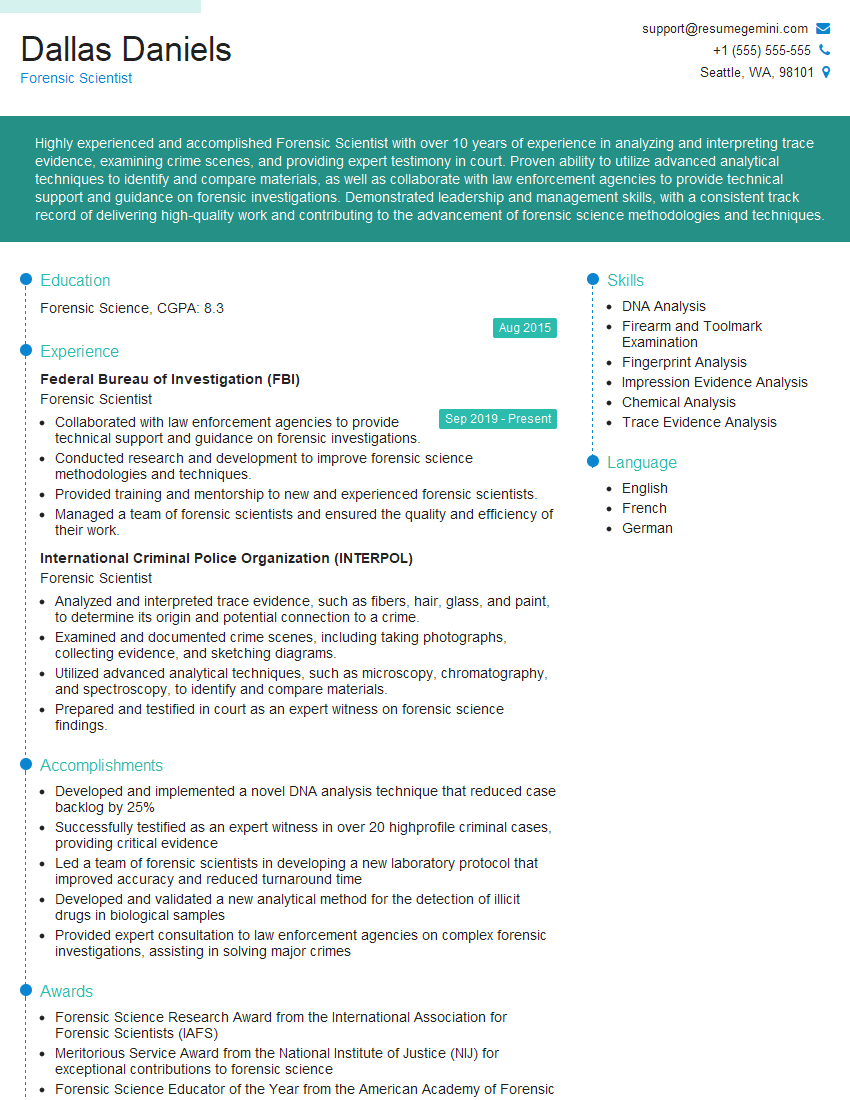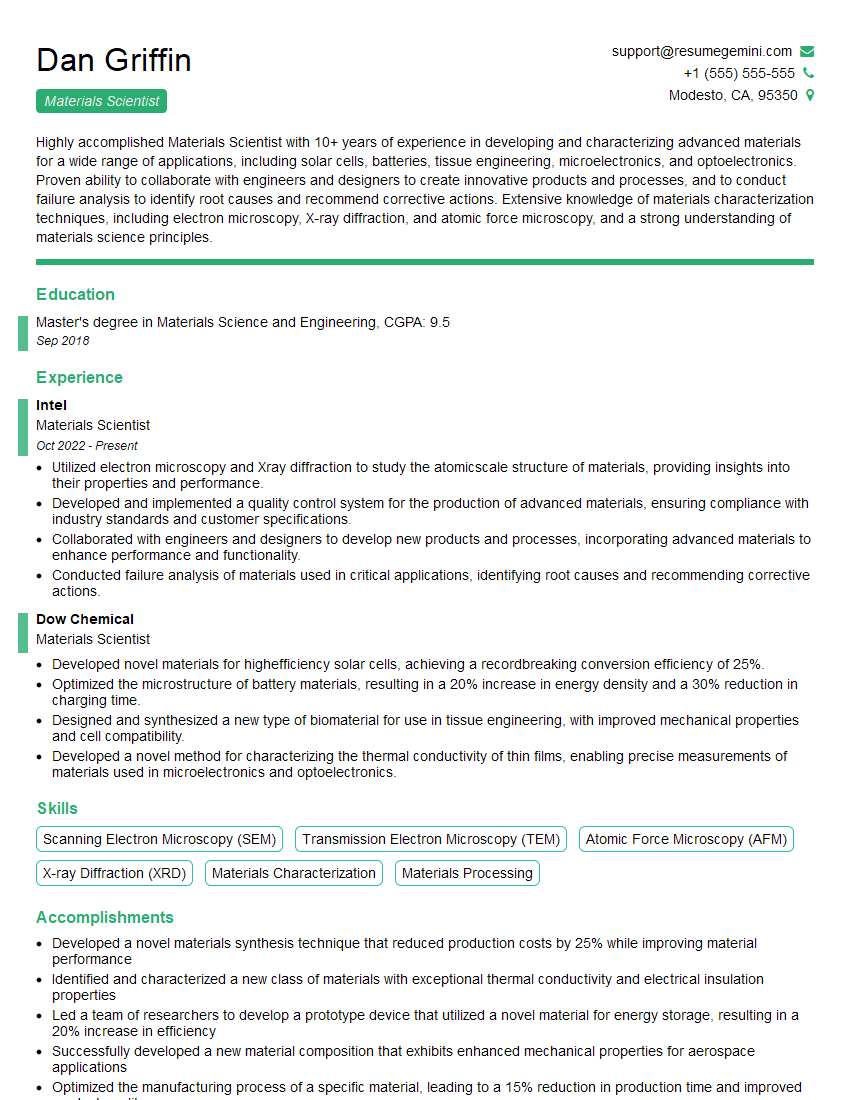The thought of an interview can be nerve-wracking, but the right preparation can make all the difference. Explore this comprehensive guide to Knowledge of Lab Techniques and Equipment interview questions and gain the confidence you need to showcase your abilities and secure the role.
Questions Asked in Knowledge of Lab Techniques and Equipment Interview
Q 1. Describe your experience with different types of pipettes and their applications.
Pipettes are essential tools for precise liquid handling in the lab. My experience encompasses various types, each suited to different applications.
- Pasteur pipettes: These simple glass pipettes are used for transferring small volumes of liquids without precision. Think of them as the ‘eyeball’ method – suitable for quick transfers where exact volume isn’t critical. I’ve used them for adding reagents to staining solutions in microbiology.
- Graduated pipettes (Mohr and Serological): These offer marked graduations along the length allowing for dispensing varying volumes. Mohr pipettes have graduations to the tip, while serological pipettes have graduations that extend to the tip. I often used them in biochemistry experiments requiring the measurement of relatively larger, but not extremely precise, volumes like preparing dilutions.
- Volumetric pipettes: Designed to deliver a single, precise volume indicated by a mark on the neck. They’re crucial for preparing standard solutions, where accuracy is paramount. For example, I relied heavily on these when creating calibration standards for spectrophotometry experiments.
- Micropipettes (P20, P200, P1000 etc.): These are essential for dispensing microliter volumes with high accuracy and precision, especially in molecular biology, PCR setup, and ELISA. They’re my go-to tools for delicate procedures, needing to dispense precise volumes of enzymes or DNA samples.
Selecting the appropriate pipette depends entirely on the application. A volumetric pipette is ideal for preparing a standard solution, while a micropipette is necessary for PCR reactions. The precision requirements of the experiment will always dictate the pipetting technique chosen.
Q 2. Explain the process of preparing a standard solution.
Preparing a standard solution is fundamental to quantitative analysis. It involves dissolving a precisely weighed amount of solute (the substance being dissolved) in a specific volume of solvent (usually water) to create a solution of known concentration.
Let’s say we need to prepare 100 ml of a 1M (1 molar) NaCl solution. The molar mass of NaCl is approximately 58.44 g/mol. This means 1 mole of NaCl weighs 58.44g.
- Calculate the required mass: We need 1 mole per liter (1000ml), so for 100ml, we need (1 mol/1000ml) * 100ml = 0.1 moles of NaCl. Therefore, we need 0.1 mol * 58.44 g/mol = 5.844 g of NaCl.
- Weigh the solute: Using an analytical balance, carefully weigh out 5.844 g of NaCl. Ensure the balance is calibrated and tared (zeroed) before weighing. Accuracy is key here.
- Dissolve the solute: Transfer the weighed NaCl to a volumetric flask of appropriate size (100 ml in this case). Add a small amount of solvent (distilled water), swirl gently to dissolve the salt completely. Avoid losses!
- Fill to the mark: Once the NaCl is dissolved, carefully add more distilled water until the bottom of the meniscus is precisely at the 100 ml mark on the flask. Avoid overfilling.
- Invert and mix: Stopper the flask and invert it several times to ensure thorough mixing and homogeneity of the solution.
Label the flask clearly with the solution’s identity, concentration, and date of preparation. This meticulous process ensures the accuracy and reliability of subsequent experiments dependent on this standard solution.
Q 3. How would you calibrate a pH meter?
Calibrating a pH meter is essential to ensure accurate measurements. pH meters measure the hydrogen ion concentration of a solution, and these instruments drift over time, so regular calibration is necessary. Calibration involves using buffer solutions of known pH values.
- Prepare buffer solutions: Obtain commercially available buffer solutions of at least two different pH values, typically pH 4.0, 7.0, and 10.0. The choice of buffers should span the anticipated range of pH values to be measured.
- Turn on the pH meter: Allow sufficient time for the instrument to warm up and stabilize.
- Rinse the electrode: Rinse the pH electrode thoroughly with distilled water and gently blot dry with a lint-free tissue. Avoid touching the sensitive sensing bulb directly.
- Calibrate with the first buffer: Immerse the electrode in the first buffer solution (e.g., pH 7.0). Stir gently. Once the reading stabilizes, use the calibration function on the meter to adjust the reading to match the exact pH of the buffer solution.
- Calibrate with the second buffer: Rinse the electrode again. Immerse the electrode into the second buffer solution (e.g., pH 4.0). Follow the same steps as above, using the calibration function to adjust the reading to match the known pH value.
- Optional third buffer: For higher accuracy, a third buffer solution (e.g., pH 10.0) may be used for calibration.
- Verify calibration: After calibration, it is good practice to measure the pH of the buffer solution once again to confirm its accurate value and assess the stability and precision of the calibration process. If significant deviation is observed, repeat the process.
Regular calibration, typically before each use or at least daily, ensures accurate and reliable pH measurements. This is crucial in numerous applications, from monitoring water quality to optimizing biological experiments.
Q 4. What are the safety precautions for handling hazardous chemicals?
Handling hazardous chemicals requires strict adherence to safety protocols. Negligence can lead to serious consequences, including injury or environmental damage.
- Personal Protective Equipment (PPE): Always wear appropriate PPE, including lab coats, safety glasses or goggles, gloves (chosen based on chemical compatibility), and potentially a respirator if dealing with volatile or airborne hazards.
- Proper ventilation: Work in a well-ventilated area or use a fume hood for volatile or toxic chemicals.
- Safe handling procedures: Use appropriate techniques for handling chemicals, including careful dispensing and avoiding spills. Never pipette by mouth!
- Chemical compatibility: Ensure that the chosen gloves and containers are compatible with the chemicals being handled, to prevent leaks or reactions.
- Waste disposal: Follow established waste disposal procedures for each chemical. Never mix incompatible chemicals.
- Safety data sheets (SDS): Before handling any chemical, consult the SDS for detailed information on hazards, handling, and disposal procedures. This is a non-negotiable step.
- Emergency preparedness: Know the location of safety equipment, such as eyewash stations and safety showers, and be aware of emergency procedures.
A simple example: when working with concentrated acids, always add acid to water slowly while stirring—never water to acid—to prevent splashing and heat generation. Safety isn’t just a protocol; it’s a commitment to responsible laboratory practice.
Q 5. Describe your experience with spectrophotometry and its applications.
Spectrophotometry is a powerful technique used to measure the absorbance or transmission of light through a solution. It relies on the principle that different substances absorb light at specific wavelengths.
My experience includes using UV-Vis spectrophotometers extensively to quantify proteins, DNA, and other biomolecules. For instance, the Bradford assay uses spectrophotometry to determine protein concentration by measuring the absorbance at a specific wavelength after reaction with a dye.
- Quantitative analysis: Spectrophotometry is critical for quantitative analysis, allowing us to determine the concentration of a substance based on its absorbance. Beer-Lambert law governs this relationship.
- Enzyme kinetics: It’s useful for studying enzyme kinetics by monitoring the changes in absorbance over time as an enzyme catalyzes a reaction.
- Purity analysis: Spectrophotometry can help assess the purity of a sample by checking for the presence of contaminants. If there are unexpected absorbance peaks, this suggests impurities.
In practice, I’ve used spectrophotometry for various applications, from measuring the concentration of bacterial cultures to analyzing the kinetics of enzymatic reactions. The versatility and relative simplicity of the method make it indispensable in many laboratory settings.
Q 6. Explain the principles of chromatography.
Chromatography is a separation technique used to separate components of a mixture based on their differential partitioning between a stationary phase and a mobile phase. Think of it like a race, where different components move at different speeds depending on how much they interact with the ‘track’ (stationary phase).
There are various types of chromatography, including:
- Thin-layer chromatography (TLC): A simple and rapid technique using a thin layer of absorbent material (like silica gel) on a plate. The mobile phase moves up the plate by capillary action, separating components based on their polarity and affinity for the stationary and mobile phases.
- Gas chromatography (GC): Separates volatile compounds based on their boiling points and interactions with a stationary phase within a column. A carrier gas carries the sample through the column, and components are detected as they elute. It’s very good at separating volatile organic compounds.
- High-performance liquid chromatography (HPLC): Employs high pressure to force the mobile phase (a liquid) through a packed column, separating components based on their interactions with the stationary phase. It’s highly versatile, capable of separating a wider range of compounds than TLC or GC.
The choice of chromatography technique depends on the nature of the sample and the desired separation. For instance, TLC is ideal for quick preliminary separations, while HPLC is preferred for complex mixtures requiring high resolution.
Q 7. What are the different types of microscopes and their applications?
Microscopes are invaluable tools for visualizing small structures. Different types exist, each optimized for specific applications.
- Light microscopes: These use visible light to illuminate the sample, offering relatively simple operation. Subtypes include bright-field, dark-field, phase-contrast, and fluorescence microscopy, each with its advantages and applications. Bright-field microscopy is the most common for observing stained cells, while fluorescence microscopy is essential for visualizing specific molecules labeled with fluorescent dyes.
- Electron microscopes: These use a beam of electrons instead of light, offering significantly higher resolution, allowing visualization of subcellular structures like organelles. Transmission electron microscopy (TEM) provides high resolution images by passing the electron beam through a thin sample, revealing internal structure. Scanning electron microscopy (SEM) scans the surface of the sample with an electron beam, producing detailed 3D images of the sample’s surface.
- Scanning probe microscopes: These use a sharp tip to scan the surface of a sample, creating images with atomic resolution. Techniques like atomic force microscopy (AFM) and scanning tunneling microscopy (STM) are used to study surface properties at a nanometer scale.
The choice of microscope depends entirely on the size and nature of the sample and the level of detail required. Light microscopy is sufficient for many biological applications, but electron microscopy is needed for visualizing ultrastructures and nanomaterials. The resolution and capabilities are key to choosing the right instrument.
Q 8. How do you ensure accurate measurements in the lab?
Accurate measurements are the cornerstone of reliable experimental results. Ensuring accuracy involves a multi-pronged approach encompassing proper instrument selection, calibration, and technique.
- Instrument Selection: Choosing the right instrument for the task is crucial. For example, using a micropipette for precise measurements in the microliter range, rather than a graduated cylinder, minimizes error. Always check the instrument’s specifications to understand its accuracy and precision.
- Calibration and Verification: Regularly calibrating instruments against known standards is non-negotiable. This ensures they’re providing accurate readings. For example, analytical balances should be calibrated with certified weights at least annually or even more frequently depending on use. We also use control samples to verify instrument performance and method validity.
- Technique: Proper technique is vital. This includes ensuring proper pipetting techniques (avoiding air bubbles, using correct pipette tips), correctly leveling balances, and reading menisci accurately. Taking multiple measurements and calculating the average further improves accuracy and minimizes random errors.
- Environmental Factors: Temperature and humidity can affect measurements. For instance, maintaining a consistent temperature is vital for accurate volumetric measurements. Ensuring that the lab environment is free from vibrations is essential when using sensitive instruments like analytical balances.
In my experience, a meticulous attention to detail in these areas is essential for generating high-quality, reliable data.
Q 9. Describe your experience with sterile techniques.
My experience with sterile techniques spans several years and various applications, from cell culture to microbiology experiments. I’m proficient in aseptic techniques, including using laminar flow hoods, autoclaves, and different sterilization methods. I understand the importance of maintaining sterility to avoid contamination and ensure the validity of experiments. For example, in cell culture, contamination can lead to inaccurate experimental results, requiring repeated procedures and wasting resources. In microbiology, maintaining sterility ensures that the cultured microorganisms are of a single species, preventing misleading findings.
I’ve routinely handled various pathogens and have undergone extensive training in biosafety procedures. I’m familiar with various levels of biosafety containment and can work safely and efficiently within those guidelines.
Q 10. Explain the process of performing aseptic techniques.
Aseptic techniques aim to prevent contamination of sterile materials and environments with microorganisms. Think of it as creating a ‘bubble’ of sterility around your work. The process generally involves these steps:
- Preparation: Thoroughly clean and disinfect the work area using appropriate disinfectants like 70% ethanol. Wear appropriate personal protective equipment (PPE) including gloves, lab coat, and eye protection.
- Sterilization of Materials: Sterilize all equipment and media that will come into contact with the sterile environment using an autoclave (for heat-stable materials) or by filtration (for heat-sensitive materials).
- Laminar Flow Hood: If using cell cultures or working with highly sensitive materials, perform the work within a laminar flow hood. This creates a sterile airflow to minimize contamination. Remember to properly sanitize the hood before and after use.
- Aseptic Procedures: Work methodically, avoiding unnecessary movements and keeping sterile materials within a defined sterile field. Use sterile transfer techniques, such as flaming inoculating loops or needles before and after use.
- Post-Procedure: Properly dispose of all contaminated materials and sterilize reusable items.
Imagine preparing a delicate cake – any contamination (like a stray crumb) can ruin the entire thing. Similarly, aseptic techniques ensure that our experiments aren’t ‘ruined’ by unwanted microbial growth.
Q 11. What is your experience with PCR and its applications?
Polymerase Chain Reaction (PCR) is a cornerstone technique in molecular biology that allows for the amplification of specific DNA sequences. My experience with PCR is extensive, encompassing various applications such as:
- DNA Cloning: Generating multiple copies of a specific gene for further study or manipulation.
- Diagnostic Testing: Detecting the presence of pathogens (like viruses or bacteria) or genetic mutations, commonly used in medical diagnostics and forensic science.
- Genetic Research: Studying gene expression, identifying genetic markers, and performing gene sequencing.
- Forensic Science: Analyzing DNA samples from crime scenes for identification and evidence gathering.
I am proficient in designing PCR primers, optimizing reaction conditions, performing real-time PCR (qPCR), and analyzing results using various software programs. I understand the principles behind PCR, including denaturation, annealing, and extension, and can troubleshoot common issues such as primer dimers or non-specific amplification.
Q 12. How do you troubleshoot common laboratory equipment malfunctions?
Troubleshooting equipment malfunctions requires a systematic approach. I begin by identifying the problem: what isn’t working correctly? Then I take these steps:
- Check for Obvious Issues: Is the equipment plugged in? Are there any error messages displayed? Is the instrument calibrated correctly? Often, simple issues can easily be solved.
- Consult Manuals and Protocols: The instrument’s manual provides troubleshooting guides, error codes, and explanations of common problems. This is my primary source of information.
- Perform Basic Checks: Depending on the equipment, this could involve checking fuses, power cords, connections, and the overall instrument integrity.
- Systematic Elimination: If the problem persists, I begin a systematic elimination process. For example, if a centrifuge is not working, I might try a different rotor or test with a known working sample.
- Seek Assistance: If I’m unable to resolve the issue after performing thorough troubleshooting steps, I seek assistance from experienced colleagues or the equipment vendor’s technical support team. Documenting the issue and all troubleshooting steps taken is crucial for effective communication.
For instance, if a spectrophotometer is displaying inaccurate readings, I would first check its calibration, then the cuvettes for cleanliness and compatibility, and finally, the sample preparation.
Q 13. Explain the importance of proper lab notebook keeping.
Proper lab notebook keeping is paramount for ensuring reproducibility, traceability, and accuracy in scientific research. It’s the primary record of the experiment and forms a critical part of the scientific process. A well-maintained notebook should include:
- Detailed Experimental Design: Including the objective, hypothesis, methodology, and materials used, should be documented comprehensively and clearly.
- Complete Data Recording: Raw data (with units), observations, calculations, and any changes to experimental procedures should all be documented in detail. The date and time of each entry should be recorded as well.
- Error Analysis and Troubleshooting: Any problems encountered during the experiment, along with the troubleshooting steps taken, should be recorded. This allows for future improvements.
- Neatness and Organization: Entries should be clear, legible, and well-organized to ensure easy readability and comprehension.
- Data Integrity: Never erase or alter data. If an error is found, cross it out with a single line, date it, and add a brief explanation. Maintaining data integrity is critical for accurate scientific record-keeping.
Think of it as a detailed map of your experiment. A good lab notebook makes it easy for others (and your future self!) to understand what you did and reproduce your work.
Q 14. How do you handle discrepancies in experimental results?
Discrepancies in experimental results require careful investigation. My approach involves:
- Reviewing the Experimental Design and Protocol: I meticulously check the experimental procedure, ensuring each step was followed correctly. Were there any deviations from the protocol?
- Analyzing the Data: I examine the data for outliers or unusual trends. Statistical analyses help identify significant deviations and potential sources of error.
- Identifying Potential Sources of Error: This could include errors in measurement, contamination, instrument malfunction, or problems with reagents. The possibility of human error must always be considered.
- Repeating the Experiment: Repeating the experiment, ideally with modifications to address potential sources of error identified in previous steps, is often necessary to confirm or refute initial findings.
- Considering Alternative Explanations: If the discrepancy persists, I explore alternative explanations for the results, considering the implications and limitations of the experimental approach.
Documenting all steps taken to investigate discrepancies is very important. This allows for a clear understanding of the problem and the path towards resolution. It’s a crucial part of developing scientific rigor and ultimately improving our understanding.
Q 15. Describe your experience with data analysis and interpretation.
Data analysis and interpretation are crucial for drawing meaningful conclusions from experimental data. My experience spans various techniques, from basic descriptive statistics to advanced multivariate analysis. I’m proficient in using software like GraphPad Prism, R, and Excel to analyze datasets, generate graphs, and perform statistical tests such as t-tests, ANOVA, and regression analysis. For example, in a recent project involving cell viability assays, I used a two-way ANOVA to determine the effects of both drug concentration and treatment time on cell survival. The results were then visually represented using bar graphs with error bars, facilitating clear communication of findings. I always ensure my analysis is rigorous, considering potential confounding factors and limitations. Properly interpreting data involves understanding statistical significance, effect sizes, and the limitations of the methods used. A key aspect is communicating findings clearly and concisely, both visually and verbally, to a diverse audience, from fellow scientists to non-scientific stakeholders.
Career Expert Tips:
- Ace those interviews! Prepare effectively by reviewing the Top 50 Most Common Interview Questions on ResumeGemini.
- Navigate your job search with confidence! Explore a wide range of Career Tips on ResumeGemini. Learn about common challenges and recommendations to overcome them.
- Craft the perfect resume! Master the Art of Resume Writing with ResumeGemini’s guide. Showcase your unique qualifications and achievements effectively.
- Don’t miss out on holiday savings! Build your dream resume with ResumeGemini’s ATS optimized templates.
Q 16. How do you maintain a clean and organized laboratory workspace?
Maintaining a clean and organized lab workspace is paramount for safety and efficient work. My approach is multifaceted. First, I always clean up spills immediately, using appropriate cleaning agents for different types of contaminants. Secondly, I follow a ‘one-in, one-out’ policy for reagents and materials. When a new item is brought into the workspace, a similar used item is removed and appropriately discarded or stored. Third, I label everything clearly and meticulously, including storage containers, samples, and equipment. Fourth, I regularly declutter the bench, eliminating unnecessary items. Finally, I adhere strictly to the lab’s safety protocols and regularly disinfect surfaces. Think of it like a well-organized kitchen – a clean and orderly space promotes efficiency and prevents accidents. In my previous role, this systematic approach significantly reduced the risk of contamination and improved overall productivity.
Q 17. What are the different types of centrifuges and their applications?
Centrifuges are indispensable instruments for separating components of a mixture based on their density. Several types exist, each suited for specific applications:
- Microcentrifuges: Small, benchtop centrifuges used for small-volume samples (e.g., microtubes) in molecular biology applications like DNA/RNA purification.
- Refrigerated Centrifuges: Maintain a low temperature, crucial for preserving temperature-sensitive samples during centrifugation, often used in clinical and research settings.
- High-Speed Centrifuges: Generate higher centrifugal forces, enabling separation of subcellular organelles (e.g., mitochondria, lysosomes).
- Ultracentrifuges: Achieve extremely high speeds, used for isolating macromolecules (e.g., proteins, viruses) and subcellular components.
- Preparative Centrifuges: Designed for large-scale separations, used in industrial applications and large-scale sample preparations.
The choice of centrifuge depends entirely on the application. For example, if I need to pellet bacteria from a cell culture, a benchtop centrifuge would suffice. However, for isolating membrane proteins, I would require a high-speed or even ultracentrifuge.
Q 18. Explain the principles of electrophoresis.
Electrophoresis separates charged molecules based on their size and charge using an electric field. The sample is loaded into a gel matrix (agarose or polyacrylamide), which acts as a sieve. When an electric field is applied, charged molecules migrate towards the oppositely charged electrode. Smaller molecules move faster through the gel than larger ones, resulting in separation. Different types of electrophoresis exist:
- Gel Electrophoresis: Commonly used to separate DNA, RNA, and proteins.
- SDS-PAGE: Sodium dodecyl sulfate polyacrylamide gel electrophoresis separates proteins solely based on their size by denaturing them.
- Isoelectric Focusing (IEF): Separates proteins based on their isoelectric point (pI), the pH at which their net charge is zero.
Think of it like a race where smaller, faster molecules reach the finish line first. The separated molecules can then be visualized using various techniques, such as staining or fluorescence. In DNA electrophoresis, for example, we can determine the size of DNA fragments based on their migration distance in the gel.
Q 19. Describe your experience with cell culture techniques.
I have extensive experience in various cell culture techniques, including cell seeding, subculturing, cryopreservation, and transfection. I’m proficient in culturing a wide range of cell lines, both adherent and suspension cells. My experience includes maintaining sterile conditions using aseptic techniques, monitoring cell growth and viability using microscopy and assays, and optimizing culture conditions for optimal cell health. For instance, I’ve optimized culture media and growth conditions for a specific cell line to achieve high yields for downstream applications. A challenging project involved the transfection of primary human cells with a specific gene. This required careful optimization of the transfection protocol to achieve high transfection efficiency while minimizing cell toxicity. Careful record-keeping and meticulous technique were crucial to the success of this project. My attention to detail helps ensure consistent, reliable, and reproducible results in my cell culture work.
Q 20. How do you ensure the accuracy and precision of laboratory measurements?
Accuracy and precision are crucial for reliable results. I ensure this through a combination of techniques:
- Calibration of Equipment: Regularly calibrating instruments like balances, pipettes, and spectrophotometers using certified standards is essential. This ensures that the equipment is measuring accurately.
- Proper Pipetting Technique: Employing correct pipetting techniques minimizes errors in sample preparation. Regular practice and calibration of pipettes are key.
- Using Appropriate Controls: Including positive and negative controls in experiments allows for assessment of the validity of the results.
- Multiple Measurements/Replicates: Performing multiple measurements and incorporating replicates in experiments reduces random errors and improves the reliability of the data. Analyzing data statistically is crucial for interpreting results correctly.
- Maintaining Accurate Records: Meticulous record-keeping is essential for tracking samples and data, which are crucial for ensuring data integrity.
For example, in a protein quantification assay, I would use a standard curve to calibrate the spectrophotometer and perform multiple replicates to minimize errors. This systematic approach ensures that my measurements are both accurate and precise, and reliable conclusions can be drawn from the data.
Q 21. What are the different types of glassware used in the laboratory and their applications?
Various types of glassware are used in the lab, each with specific applications:
- Beakers: Used for mixing, heating, and stirring liquids. They are not precise measuring vessels.
- Erlenmeyer Flasks (Conical Flasks): Ideal for mixing and swirling liquids, often used in titrations and cell cultures.
- Volumetric Flasks: Designed for precise preparation of solutions with specific volumes.
- Graduated Cylinders: Used for measuring volumes, although less precise than volumetric flasks.
- Pipettes (various types): Transfer specific volumes of liquids accurately. Types include volumetric, graduated, and micropipettes.
- Test Tubes: Used for small-scale reactions and experiments.
- Petri Dishes: Used for growing bacteria and cells.
The selection of glassware depends heavily on the experiment. For instance, while a beaker is suitable for mixing reagents, a volumetric flask is essential for making precise standard solutions. Choosing the right type of glassware is critical for accurate and reliable experimental results.
Q 22. Explain your experience with using and maintaining analytical balances.
Analytical balances are precision instruments crucial for accurate mass measurements in various lab settings. My experience encompasses using both traditional mechanical balances and modern electronic ones. I’m proficient in various weighing techniques, including weighing by difference and taring, ensuring accurate results even with volatile or hygroscopic samples. Maintaining these balances involves regular calibration using certified weights, cleaning to prevent dust accumulation and corrosion, and careful handling to prevent damage to the sensitive internal mechanisms. For instance, in my previous role, I routinely calibrated our Mettler Toledo analytical balance using a NIST-traceable weight set, ensuring our measurements remained within the required accuracy levels for pharmaceutical analysis. I also implemented a detailed cleaning and maintenance log to track calibration dates and identify any potential issues before they impacted experiments.
Q 23. Describe your experience with different types of incubators and their applications.
Incubators are essential for cultivating microorganisms and cell cultures at controlled temperatures. My experience includes working with various types, including CO2 incubators, refrigerated incubators, and shaking incubators. CO2 incubators, crucial for cell culture, maintain a precise temperature and CO2 level to simulate physiological conditions. Refrigerated incubators are used for low-temperature incubations. Shaking incubators provide agitation, vital for ensuring even oxygenation and mixing in cultures. In one project, we used a CO2 incubator to cultivate mammalian cells for a drug-screening assay, carefully controlling temperature and CO2 levels to ensure optimal cell growth and viability. The choice of incubator depends entirely on the application. For example, bacterial cultures may simply require a standard incubator, while mammalian cell lines require a CO2 incubator.
Q 24. How do you handle spills of hazardous materials in the lab?
Handling hazardous material spills requires immediate and decisive action, prioritizing safety. My approach follows established laboratory safety protocols. The first step is to evacuate the immediate area, alerting others to the spill. Then, I use appropriate personal protective equipment (PPE), such as gloves, lab coat, goggles, and sometimes a respirator, depending on the substance. The next step involves carefully containing the spill, using absorbent materials like spill pads or vermiculite. The specific cleanup procedure depends on the nature of the spill. For example, acid spills require neutralization with a suitable base, while organic solvents require absorbent materials followed by disposal according to lab safety regulations. I meticulously document the incident, including the material spilled, the amount, the time, and the cleanup procedure. Proper waste disposal is crucial, following all relevant regulations.
During my time at the research facility, we had a minor spill involving a low concentration of hydrochloric acid. We immediately evacuated the area and used sodium bicarbonate to neutralize it and cleaned it up with spill pads. The incident was thoroughly documented in the lab’s safety log. Safety training and rigorous adherence to protocols are paramount.
Q 25. What is your experience with different types of autoclaves and their applications?
Autoclaves are used for sterilization using high-pressure steam. I have experience with both benchtop and large-capacity autoclaves. Benchtop autoclaves are suitable for smaller loads, while large-capacity autoclaves are needed for larger volumes of materials. The type of autoclave used depends on the items to be sterilized and the volume. Different cycles can be programmed to optimize sterilization for specific materials; this includes adjusting parameters such as temperature and pressure. In my previous research, we used an autoclave to sterilize laboratory glassware, growth media, and other equipment before conducting microbiological experiments. Regular maintenance of autoclaves involves checking water levels, cleaning the chamber, and testing the sterilization cycle to ensure its effectiveness. For instance, we used biological indicators (spores of Geobacillus stearothermophilus) regularly to validate the autoclave’s sterilization capacity.
Q 26. Explain the principles of mass spectrometry.
Mass spectrometry (MS) is an analytical technique that measures the mass-to-charge ratio of ions. It’s based on ionizing a sample and then separating the resulting ions based on their mass-to-charge ratio. This separation allows for the identification and quantification of different molecules within a sample. The process typically involves several steps: ionization (creating ions from the sample), mass analysis (separating ions by their mass-to-charge ratio), and detection (measuring the abundance of each ion). Various ionization techniques are employed, such as electron ionization (EI), electrospray ionization (ESI), and matrix-assisted laser desorption/ionization (MALDI), each suited to different types of samples. The separated ions are detected, and a mass spectrum is generated, showing the relative abundance of each ion as a function of its mass-to-charge ratio. This spectrum can be used to identify unknown compounds by comparing it to known spectral libraries or to quantify known compounds in a sample. MS finds applications in many fields, including proteomics, metabolomics, and environmental analysis.
Q 27. Describe your experience with using and maintaining HPLC systems.
High-performance liquid chromatography (HPLC) is a powerful technique used to separate, identify, and quantify components in a mixture. My experience includes operating and maintaining various HPLC systems, from basic isocratic systems to more advanced gradient systems. I’m proficient in method development and optimization, including choosing the appropriate stationary and mobile phases to achieve optimal separation. Maintaining HPLC systems involves regular cleaning of the system, including the column, injector, and detector, to prevent clogging and maintain peak performance. Troubleshooting issues such as peak tailing, poor resolution, and system leaks is part of my routine responsibilities. In one project, I developed an HPLC method to quantify different flavonoids in plant extracts, optimizing the mobile phase composition and flow rate to achieve baseline separation of all the compounds of interest. I meticulously documented all experimental parameters, including column type, mobile phase composition, flow rate, and detector settings, to ensure reproducibility of the results. Regular system checks, preventative maintenance, and meticulous record keeping are crucial for optimal HPLC system performance.
Q 28. What are your preferred methods for documenting experimental procedures?
Detailed and accurate documentation of experimental procedures is crucial for reproducibility and sharing of scientific findings. My preferred method involves using a combination of electronic and physical lab notebooks. I use a dedicated electronic lab notebook software to record the experimental details, including detailed protocols, reagents used, instrument parameters, data tables and charts, and observations. For instance, I regularly use ELN software that allows version control, secure storage, and easy collaboration. However, I also maintain a hardcopy lab notebook to record real-time observations and any unexpected occurrences during the experiments. This dual approach ensures data backup and allows for quick referencing even without electronic access. This meticulous approach enhances data integrity and aids in reproducing the results and troubleshooting experiments. In addition, I follow specific formatting guidelines, which includes clear and concise writing with units, data tables, and clear descriptions of the methodology employed, helping to ensure the reproducibility of my research.
Key Topics to Learn for Knowledge of Lab Techniques and Equipment Interview
- Basic Laboratory Safety Procedures: Understanding and applying safety protocols, including handling hazardous materials, using personal protective equipment (PPE), and responding to emergencies. This includes theoretical knowledge of regulations and practical application in various lab settings.
- Common Laboratory Equipment Operation & Maintenance: Proficiency in using and maintaining equipment such as balances, centrifuges, spectrophotometers, autoclaves, microscopes, and pH meters. This involves understanding the theoretical principles behind their operation and troubleshooting common issues.
- Sterile Techniques & Aseptic Procedures: Mastering techniques for maintaining sterility during experiments, including proper sterilization methods and aseptic transfer techniques. This encompasses both theoretical understanding of microbial growth and practical application in preventing contamination.
- Data Acquisition & Analysis: Understanding data collection methods, proper recording techniques, and utilizing appropriate software for data analysis and interpretation. This includes theoretical knowledge of statistical analysis and practical application in generating meaningful results from experimental data.
- Specific Techniques Relevant to Your Field: Depending on your specialization (e.g., molecular biology, chemistry, microbiology), focus on techniques commonly used in that field. This includes both the theoretical basis and practical application of these specialized techniques. Examples include PCR, electrophoresis, chromatography, etc.
- Troubleshooting & Problem Solving: Developing the ability to identify and resolve common problems encountered during experiments. This is crucial and demonstrates practical application of theoretical knowledge.
Next Steps
Mastering knowledge of lab techniques and equipment is paramount for career advancement in scientific fields. A strong foundation in these areas demonstrates competence and opens doors to exciting opportunities. To significantly boost your job prospects, create a compelling and ATS-friendly resume that highlights your skills and experience effectively. ResumeGemini is a trusted resource to help you build a professional resume that showcases your qualifications. We provide examples of resumes tailored to showcase expertise in Knowledge of Lab Techniques and Equipment, ensuring your application stands out from the competition.
Explore more articles
Users Rating of Our Blogs
Share Your Experience
We value your feedback! Please rate our content and share your thoughts (optional).
What Readers Say About Our Blog
Hello,
We found issues with your domain’s email setup that may be sending your messages to spam or blocking them completely. InboxShield Mini shows you how to fix it in minutes — no tech skills required.
Scan your domain now for details: https://inboxshield-mini.com/
— Adam @ InboxShield Mini
Reply STOP to unsubscribe
Hi, are you owner of interviewgemini.com? What if I told you I could help you find extra time in your schedule, reconnect with leads you didn’t even realize you missed, and bring in more “I want to work with you” conversations, without increasing your ad spend or hiring a full-time employee?
All with a flexible, budget-friendly service that could easily pay for itself. Sounds good?
Would it be nice to jump on a quick 10-minute call so I can show you exactly how we make this work?
Best,
Hapei
Marketing Director
Hey, I know you’re the owner of interviewgemini.com. I’ll be quick.
Fundraising for your business is tough and time-consuming. We make it easier by guaranteeing two private investor meetings each month, for six months. No demos, no pitch events – just direct introductions to active investors matched to your startup.
If youR17;re raising, this could help you build real momentum. Want me to send more info?
Hi, I represent an SEO company that specialises in getting you AI citations and higher rankings on Google. I’d like to offer you a 100% free SEO audit for your website. Would you be interested?
Hi, I represent an SEO company that specialises in getting you AI citations and higher rankings on Google. I’d like to offer you a 100% free SEO audit for your website. Would you be interested?
good
